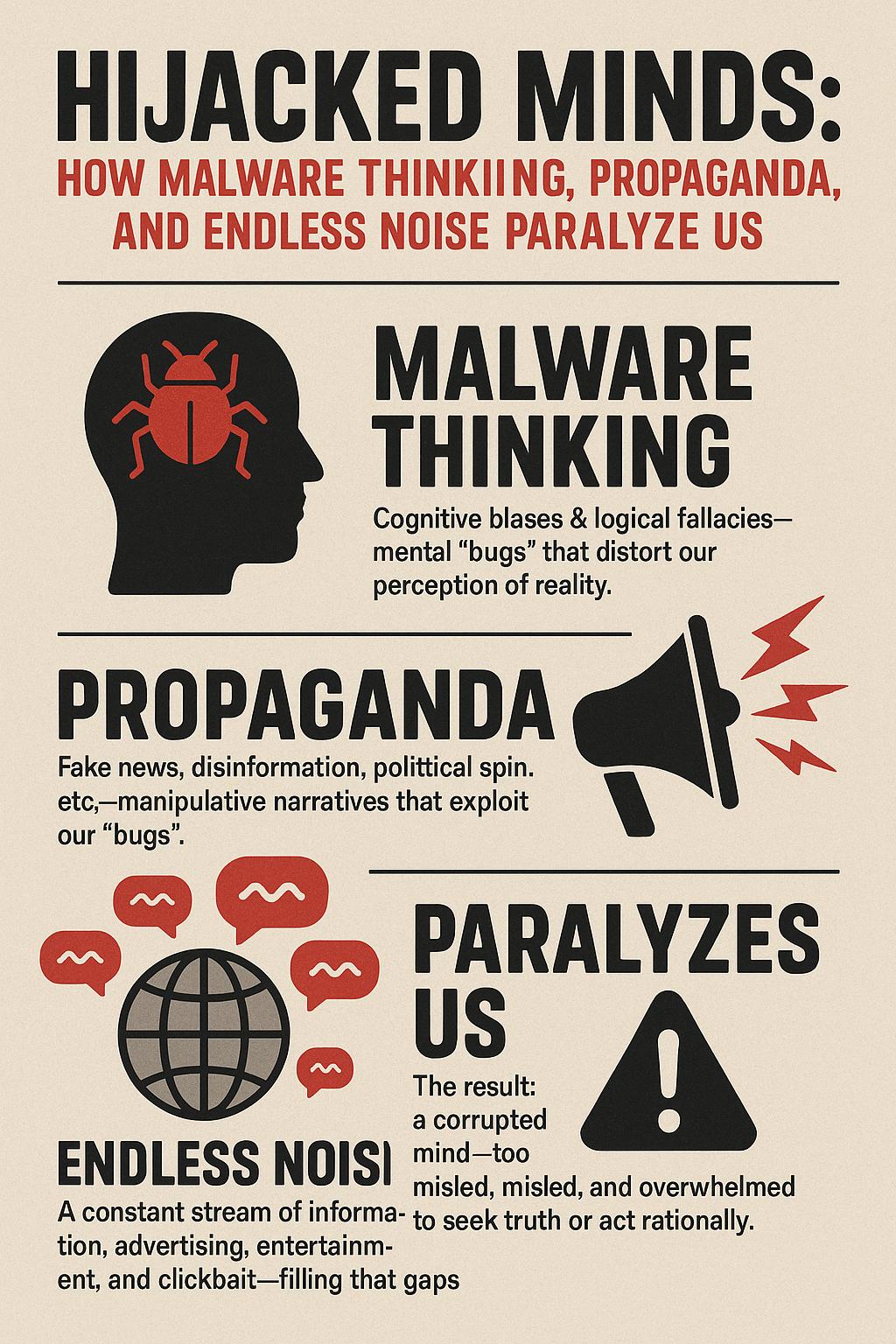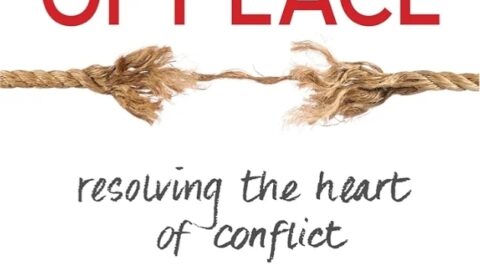The Overloaded Human Mind
On an average day, the human brain processes 300–400 distinct thoughts and emotional responses. Most of these come uninvited. They arise like pop-up notifications, demanding attention, draining energy, and pulling us away from presence. The tragedy is not that we think too much—it’s that most of what we think was never ours to begin with.
Understanding where the 300–400 distinct thoughts and emotional responses come from is vital, because it reminds us that most of the mental “pop-ups” we wrestle with every day are not pure expressions of us—they’re echoes, implants, and residues. They come from both external inputs that shape the surface of consciousness and internal layers that were stocked earlier in life (or even before life began) and now operate on autopilot. Let’s trace the main sources:
External Sources of Thought & Distraction
Media and Propaganda
News, advertising, social media feeds, and entertainment constantly inject narratives, symbols, and anxieties into our thought stream. These become mental loops: replayed outrage from a headline, a catchy song lyric, a meme, or a subconscious ad jingle. The mind treats them as “ours,” but they’re implants.
Technology and Notifications
Every ping, buzz, or red badge from a phone or computer acts like a thought-seed. Even when ignored, anticipation creates phantom notifications in the brain, priming thoughts that never came from within.
Conversations and Social Environments
Words spoken by friends, coworkers, strangers in traffic, or even overheard snippets in a café enter the brain and swirl into the day’s thought patterns. Social suggestion is one of the most underestimated drivers of “borrowed” thoughts.
Cultural Narratives & Institutions
Schools, governments, religions, and corporations set frames for what to think about—what success means, what to fear, who the heroes and enemies are. These are not spontaneous; they are pre-packaged defaults delivered into the mental landscape.
Propaganda and Agenda Setting
At a higher level, carefully engineered psychological operations (political messaging, corporate branding, state propaganda) shape entire populations’ “default thought patterns.” What seems like a personal worry (“inflation,” “safety,” “terrorism,” “the other party”) is often seeded by powerful interests.
Internal Sources of Thought & Noise
Subconscious & Unconscious Memory Banks
The mind stores observations, experiences, and emotions—many unprocessed—and replays them automatically. A smell, sound, or subtle trigger can release a flood of seemingly “random” thoughts.
Conditioned Patterns from Childhood
Behaviors, fears, and associations absorbed from parents, teachers, and peers form grooves in the subconscious. These become autopilot loops that resurface without conscious intention.
DNA and Epigenetic Imprints
We inherit not just physical traits but predispositions: temperaments, sensitivities, even trauma responses encoded in family lines. These shape thought patterns before any external culture arrives.
Environmental Programming
Repeated exposure to a neighborhood’s norms, a family’s worldview, or a culture’s default values writes scripts into the subconscious. Later in life, those scripts play out as thoughts, judgments, and emotional reflexes.
Unresolved Trauma & Emotional Residue
Emotional wounds that never healed resurface as intrusive thoughts, self-criticism, or flashbacks. These are not “new” thoughts but old signals replaying until addressed.
Dream Residues & Archetypal Unconscious
The unconscious speaks in symbols through dreams and archetypal imagery. Sometimes stray fragments bubble up into waking consciousness, producing sudden images, fears, or impulses we don’t recognize as ours.
The Core Tragedy
When 300–400 of these fragments hit the mind each day, they drain presence and scatter focus. The real tragedy is not sheer volume—it’s misattribution (misaligned priorities and the wrong ladder). We confuse externally seeded scripts and inherited autopilot loops with authentic thought. In reality, much of what we call “my thinking” is cultural malware or subconscious playback.
The task of reclaiming sovereignty, then, is twofold:
- Guarding the gates of external input (media, propaganda, tech distractions).
- Excavating the archives of the subconscious to discern what belongs to us, and what was implanted earlier by DNA, trauma, or environment.
Only then do the 300–400 daily “pop-ups” stop hijacking attention—and presence becomes possible.
Our minds have become like computers infected with silent malware. Invisible code runs in the background: rules we never consented to, fears we never chose, desires implanted by someone else’s agenda. We mistake the noise for ourselves, forgetting that beneath the chatter lies a quieter, authentic self.
From the 1990s Cool Kids to Today’s Algorithmic Cage
The 1990s gave us a taste of what cultural programming could do. Advertisers and media executives sold “rebellion” back to teenagers, manufacturing a “cool kid” archetype that was never truly authentic. Grunge fashion, MTV rebellion, even anti-establishment slogans—most were packaged commodities disguised as freedom.
Back then, the programming was loud but limited. A handful of television stations, magazines, and radio channels broadcasted the script. Today, the volume has multiplied. Social media platforms, influencer culture, micro-targeted ads, and streaming services create a 24/7 indoctrination loop. What once came through a few curated channels now floods every waking moment.
The result is cognitive paralysis. When you’re constantly chasing signals about what to wear, what to post, what to believe, who to admire, and who to despise—you never stop long enough to ask whether any of it was your idea in the first place.
Manufactured Anxieties
This conditioning has consequences. Modern anxiety is not simply the result of personal weakness—it’s the predictable outcome of a system designed to hijack attention.
- Marketing tells us we’re never enough without the next product.
- Social validation traps us in invisible competitions we never agreed to enter.
- Propaganda narrows the Overton Window, training us to see limited choices as freedom.
The more we consume, the emptier we feel. The more we conform, the more alienated we become. The more we rebel within the system’s terms, the deeper we remain trapped in its design.
A Hijacked Operating System
Put simply: the modern mind runs on someone else’s operating system. Every ad, every “like,” every headline is a line of code written to control behavior. The end product is predictable: paralysis, anxiety, and a constant background hum of dissatisfaction.
And this was not accidental. It is the business model of late modernity. Your attention is the product. Your emotions are the commodity. Your anxiety is the engine.
If We Don’t Reclaim Our Minds, the Enemy Will
The greatest danger of a hijacked mind is not the noise itself—it’s the vacancy it creates. Every thought left unexamined, every belief absorbed without question, becomes an open door. And where there is an open door, something—or someone—will walk in.
History shows this pattern with frightening clarity. Propaganda doesn’t simply inform; it occupies. Advertising doesn’t merely persuade; it implants desires that feel like our own. Education systems built for obedience don’t just teach facts; they hardwire conformity and suppress critical thought. If we do not consciously guard our inner terrain, others will map it for us—corporations, politicians, demagogues, or the algorithm that learns us better than we know ourselves.
This is not abstract. The human brain processes 300–400 uninvited thoughts and emotional spikes every day. Each is an opportunity for outside influence. Left unchecked, these “mental pop-ups” become malware: draining presence, steering behavior, and normalizing lies. What is at stake is not simply clarity of thought—it is sovereignty itself.
And here lies the core warning: if we don’t reclaim our minds, the enemy will. The “enemy” (someone or something that doesn’t have your best interest in mind) is not just a government, a corporation, or an ideology—it is anything that thrives on our passivity. It is the machine that feeds on attention, the market that monetizes our impulses, the propaganda that seeds division, the creeping normalization of comfort over courage. When we surrender the responsibility to think, others will gladly think for us, and in doing so, they will own us.

Reclaiming the mind, then, is not optional. It is the first act of resistance. It means questioning the narratives that arrive pre-packaged. It means filtering the flood of media, slowing down the reflex, and distinguishing between what is authentically ours and what was planted there. It means becoming the gatekeeper of thought, refusing to outsource conscience, attention, or imagination.
In every era, those who failed to reclaim their minds became tools of the empire, pawns in the game, or compliant consumers in systems that drained them dry. But those who reclaimed their minds—those who saw the implants for what they were—became transitional characters in history, breakers of cycles, builders of something freer.
The battle is not for territory, money, or even power. The first battlefield is the mind. And whoever wins that ground will dictate the rest.
The Way Out
The first step is not rebellion but recognition. When you notice the malware—when you see that 90% of your thoughts are inherited, implanted, or manipulated—you create space for something different. That space is where freedom begins.
To reclaim ourselves, we must:
- Audit our inputs — ruthlessly question which voices we allow in.
- Detach from validation cycles — learn to live without applause.
- Choose silence and stillness — give the authentic self space to breathe.
This is not easy—but it is necessary. Because until we uninstall the malware or unplug from the Matrix, we will continue to mistake our programming for our personality.







